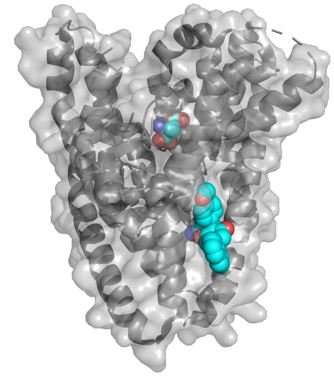The binding site of the EAAT1 inhibitor (UCPH101) is resolved by X-ray crystallography and is located at a distance from the substrate binding site. The substrate is shown in the center of the transporter, while the inhibitor is located between the translocation and scaffold domain of the transporter (lower right). The inhibitor glues the two domains together, thereby inhibiting transport. Credit: Stefan Broer
In the April 2018 issue of SLAS Discovery, a review article by Prof. Stefan Broer, Ph.D. of the Australian National University highlights opportunities and challenges in using amino acid transporters as drug targets. Amino Acid Transporters as Disease Modifiers and Drug Targets provides an overview of methods used to identify new inhibitors for amino acid transporters and outlines cell and organ function where these can be used to modulate, prevent or to treat diseases.
The review highlights the demand for better inhibitors of amino acid transport processes and outlines promising new strategies and targets to develop amino acid transporters as drug targets. Cancer cells, for instance, need essential amino acids to proliferate and metastasize. Amino acid transporters are essential for capturing of nutrients from blood vessels, which can be blocked by specific inhibitors.
This is an area of active research and a promising strategy to treat cancer. In the brain, amino acids serve as excitatory and inhibitory neurotransmitters, which are quickly removed to terminate nerve impulses. Amino acid transporters can be targeted to enhance inhibition or excitation, a strategy used to treat chronic pain and possibly schizophrenia and general brain damage.
Amino acids are generated from the breakdown of protein nutrition and are required as nutrients for cell growth, neurotransmission in the brain and cellular metabolism. Blocking some of these functions can treat diseases such as cancer, diabetes and chronic pain.
More information: Stefan Bröer, Amino Acid Transporters as Disease Modifiers and Drug Targets, SLAS DISCOVERY: Advancing Life Sciences R&D (2018). DOI: 10.1177/2472555218755629
Provided by SLAS (Society for Laboratory Automation and Screening)





















